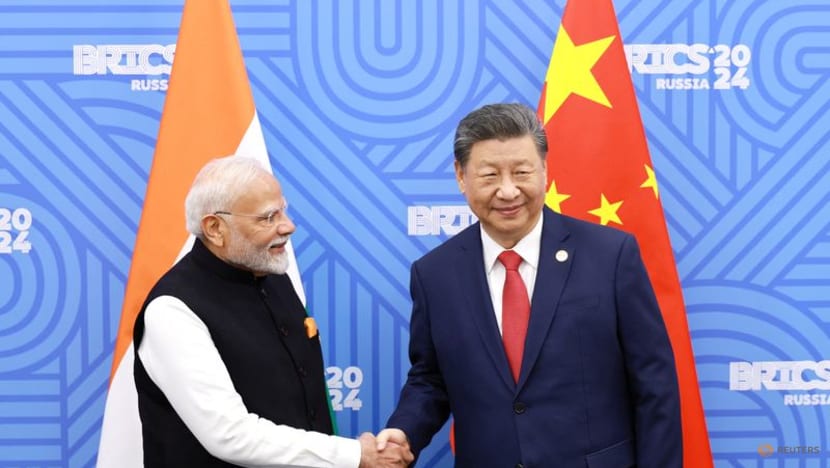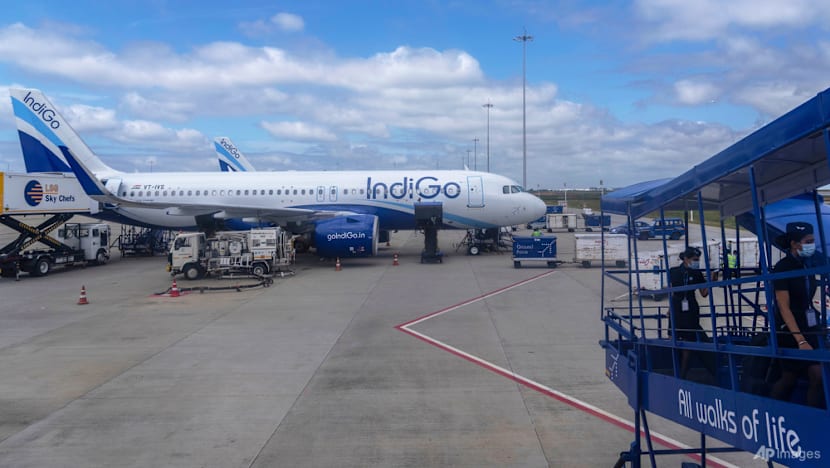Commentary: Is the India-China detente real?
Existential differences and longstanding distrust make the current normalisation of relations between India and China deeply unstable, says an international relations observer.

Chinese President Xi Jinping and India Prime Minister Narendra Modi meet on the sidelines of the BRICS summit in Kazan, Russia on Oc 23, 2024. (File photo: Reuters/China Daily)

This audio is generated by an AI tool.
GOA, India: This week, Indian airline IndiGo flew one of its A320 planes from Kolkata to Guangzhou. It was the first direct flight from India to China in five years, following its halt during the COVID-19 pandemic and the souring of relations between the two neighbours in 2020 amid the border standoff that extended the freeze.
In November, more flights, including Chinese carriers, will take to the sky, connecting New Delhi with Chinese cities. The resumption of direct air services is part of the increasing number of confidence-building measures undertaken by both countries to move past a history of distrust and adversarial relations. A detente is seemingly underway.
However, on closer examination, the embrace appears more cautious and fragile.
Since the Oct 2024 BRICS summit in Kazan, where Indian Prime Minister Narendra Modi and Chinese President Xi Jinping held a bilateral meeting, both countries have made significant progress in stabilising their border. Although criticised by the Indian opposition political parties, who term it an ad hoc move that has cemented Chinese control over vast expanses of land formerly under Indian control, a process to start negotiations on the contentious boundary issue has been set in motion. The actual process may not yield much but it gives New Delhi more time to develop its border infrastructure to match that of China’s.

THE SPECTRE OF NORMALISATION
In recent months, both sides have unveiled more confidence-building measures. In June 2025, China acceded to India’s request to resume the Kailash Mansarovar pilgrimage, in which Indian Hindu pilgrims travel to the holy mountain and lake in Tibet. In August, Beijing also lifted the embargo on the supply of specialty fertilisers, rare earths and tunnel boring machines to India. Reciprocating the gestures, India lifted its five-year-long restrictive visa process for Chinese tourists in July.
If frequent high-level visits between countries are pointers towards attempts to mend frayed ties, both India and China have more than a handful of them.
In June and July, India’s National Security Adviser Ajit Doval and External Affairs Minister S Jaishankar travelled to Beijing to meet Wang Yi, the Chinese Minister of Foreign Affairs. In August, Wang travelled to New Delhi to hold the 24th round of the Special Representative talks with Doval on the Indo-China boundary. Later that month, Modi travelled to Tianjin to attend the Shanghai Cooperation Organization summit, where he met Mr Xi on the sidelines. Both leaders welcomed “the positive momentum and steady progress in bilateral relations”, India’s Ministry of External Affairs said in a press release.
This reiteration of the positive trajectory in relations by both sides, replacing the frequent acrimonious barbs of the past four years, seems to be the new normal. And yet, the spectre of normalisation remains mostly aspirational, marked by irreconcilable differences, even more apparent in the broader context of which such normalisation is being attempted.
DISTRUST AND COMPETITION
The present thaw between India and China is happening at a time of high tariffs imposed by the Trump administration on both countries. China sees the imposition of 50 per cent tariffs on Indian exports to the United States as an opportunity to pull India out of the American sphere of influence.
However, for New Delhi, whose great power ambition is inherently linked to forging closer strategic ties with the United States, it could mostly be a question of managing its relations with China without sacrificing its core interests. Not surprisingly, Modi’s China visit in August was preceded by a two-day official tour to Tokyo. He returned home without attending the Victory Day Parade in Beijing, which celebrated China’s victory over Japan at the end of World War II.
In July, senior Indian military officials accused China of logistically assisting Pakistan during the brief India-Pakistan conflict of May 2025. China’s attempts to develop trilateral arrangements with Pakistan and Bangladesh on the one hand, and Pakistan and Afghanistan on the other, continue to heighten New Delhi’s longstanding concerns of being encircled by a Chinese “string of pearls”.
For China, India’s evasive commitment to a “One China policy” and strengthening ties with Taiwan remain irritants. The issue of the Dalai Lama’s reincarnation and advice by an Indian Cabinet minister for the matter to be treated internally by Tibetans has drawn Chinese ire, with China going on to describe it as a “thorn” in bilateral relations. And on trade, the Indian media is currently abuzz with talk of new curbs on specialty fertilisers from China.
As each side attempts to normalise relations and portray a detente as a strategic necessity, neither country is shying away from issues that divide them or invoke leverage points. This makes the status quo somewhat unreal and extremely unstable. The possibility of armed conflict between the two is remote. But deep distrust and competition will remain the defining features of their relations.
Dr Shanthie Mariet D’Souza is the founder and president of Mantraya Institute for Strategic Studies (MISS), a senior research fellow at University of Massachusetts Amherst, and visiting faculty at the Naval War College, Goa, India. This article was first published on Lowy Institute's The Interpreter.















